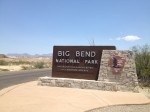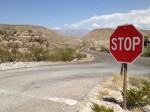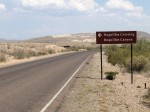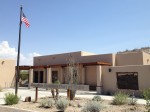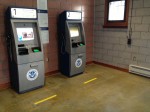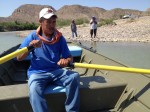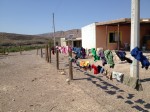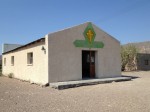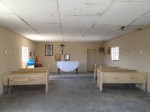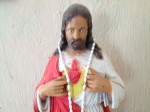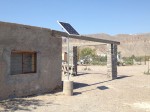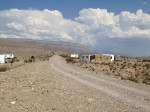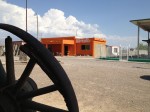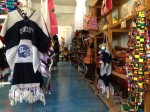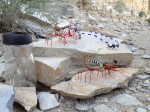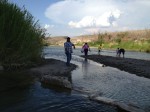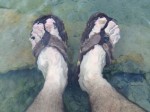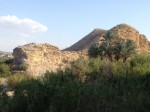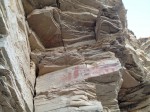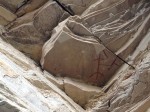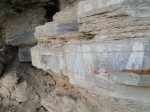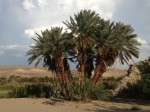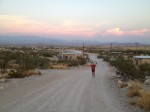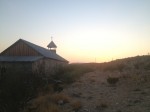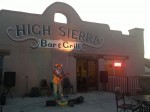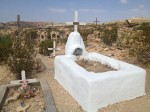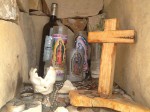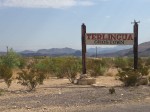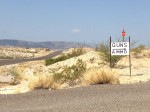After a hearty breakfast, Lupita and I set out for Big Bend National Park and the Boquillas border crossing.
It was a two-hour drive with no cell phone service to the town of Study Butte where we made a pit stop.
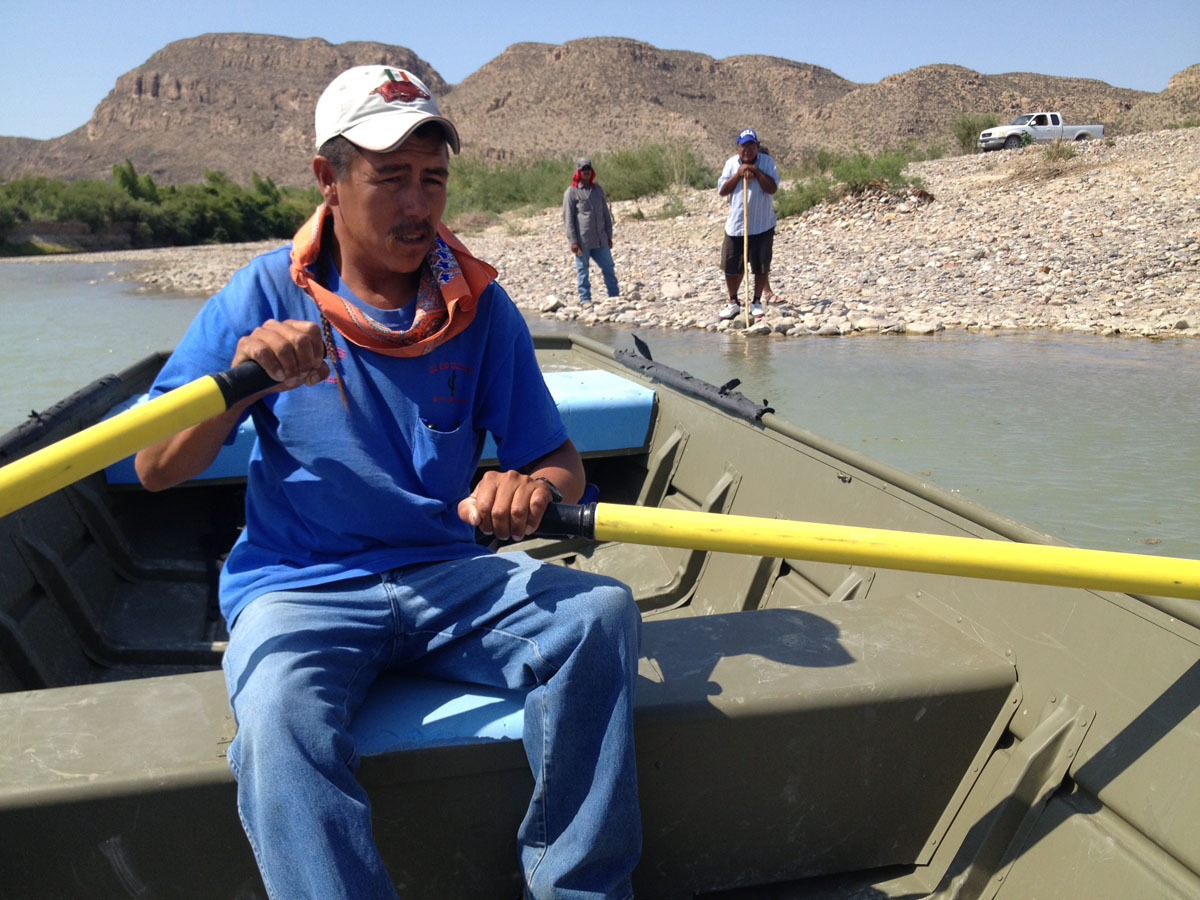
You can cross on foot or pay a couple of bucks to be taken across in a row boat. (Sergio Chapa/Borderzine.com)
We were puzzled to watch a woman mumbling to herself and waging an unceasing war with a flyswatter to kill flies on a bench outside the store.
For every fly that she killed, five more seemed to take its place.
It was a 100 degrees and seemed too hot to expend that much energy on anything.
We shrugged and continue on to the Big Bend National Park, the largest park along the Rio Grande River on the Texas side of the border.
But distances are vast in West Texas.
After passing the entrance to the park, we still had 40 minutes to the visitor’s center and another hour to the Boquillas del Carmen crossing.
At one point, there was a fork in the road.
One lead to the majestic Santa Elena Canyon along the Rio Grande River where steep, colorful and smooth cliffs wall in the river on both sides of the border.
The other road lead to the visitor’s center and the Boquillas border crossing.
Since our mission was to see the border and all its crossings, we chose the second.
Boquillas del Carmen
For decades, the Boquillas del Carmen crossing was a favorite for visitors to Big Bend National Park seeking Mexican souvenirs, hospitality and a cold beer.
But with no actual customs checkpoint, the crossing became a national security concern after the 9-11 terrorist attacks.
The U.S. Department of Homeland Security (DHS) shut down the crossing until April 2012 when an officials opened a customs checkpoint.
Unlike other border crossings, there are no customs officers at the Boquillas del Carmen crossing.
A park ranger runs through a checklist of do’s and don’ts but the actual customs inspection is done through a camera-operated kiosk.
The customs officer on the other side of the line is actually hundreds of miles away in El Paso.
We arrived at mid-afternoon, so we didn’t waste any time because the border crossing closes at 5 p.m. Wednesday through Sunday.
Although the Rio Grande River in Big Bend is shallow enough to cross on foot, we paid a few dollars to be ferried across in a row boat.
Once on the Mexican side of the river, there are two options: take a truck into town or go on horseback.
Since we only had a couple hours of time, we chose to pay a couple bucks extra for the truck.
Lupita is a Mexican national, so she didn’t need a tourist visa, but they made me stop at a makeshift customs office inside a mobile home to get one and pay for it.
Once that was done, the truck driver gave us a personal tour of the town: homes, the church, the school, the surrounding mountains.
The sky, clouds and mountains are majestic creating a contrast to the humble cinder block homes and buildings.
We noticed there are no power lines but the Coahuila government provided solar energy panels for each home and business to provide electricity.
Our guide said it was too impractical to run power lines over such a great distance to provide power to such few homes but he said the solar panels provided most of what they needed.
He wanted to take us to see some thermal hot springs but we didn’t have the time.
We were headed to a bar for a cold beer on a hot day but while walking by it we had a man and woman arguing. We saw him slap her and then shut the bar door.
Lupita and I wondered if she was a prostitute or a cantinera, which is Spanish for bar maid.
We stopped at a restaurant down the street where we got a beer and bought a few souvenirs to help the local economy.
Hot Springs
We breathed a sigh of relief after making it back to the customs checkpoint on the American side of the border with only a couple of minutes to spare.
But the sunset doesn’t set until 9 p.m. in the summer, so we had time for a little more sightseeing in the park.
On the advice of a friend, we went to the nearby hot springs.
The thermal springs are located along the edge of the Rio Grande River where people stacked some limestone bricks in a semi-circle to create a small hot tub.
It’s a small spring-fed pool with hot water that flows over the edge and joins the Rio Grande River.
Many say the hot springs are medicinal and its easy to see why.
The soft and slippery mud has an instant effect on your feet while the warm water soothes and relaxes.
We did some exploring along the trail to the hot springs and found souvenirs for sale along the rocks.
Although they’re “not supposed to do it,” residents of Boquillas del Carmen cross the river to leave souvenirs and a donation jar.
We imagine that they cross at night or early morning hours to check the jars for cash and restock their informal souvenir shop.
But the Big Bend is full of surprises and near the hot springs, we found some Native American cave paintings.
We also found a grove of palm trees that made a nice picture of an oasis in the high desert.
The Rocks Cry Out
Sadly, that was all the time we had to see the Big Bend.
Driving back through the desert, the sun was lowering but had not yet set.
The sun hit the rock, mountains and spiraling ocotillo cactuses at just the right angle.
We talked about how beautiful the desert was and what a spiritual place it can be to do some soul-searching.
I asked Lupita if she had ever heard the Biblical saying “the rocks cry out.”
Taken from Luke Chapter 19 in the Gospels, it talks about Jesus entering Jerusalem on what is now known as Palm Sunday.
Jesus was entering the Holy City as the people laid down palm branches and clothes in his path.
The crowd was praising Jesus saying, “Blessed is the king who comes in the name of the Lord” and “Peace in heaven and glory in the highest!”
The Pharisees asked Jesus to rebuke them and tell them to be quiet but he replied, “If I tell them to be silent, the rocks will cry out.”
Many interpret the passage as meaning, if men do not praise God, the rocks themselves will cry out to exclaim his glory.
That phrase was not lost on us in the Big Bend where are easily more rocks than people.
Ghost Town
We made it to the ghost town of Terlingua just before sunset.
Lupita and I got to explore the old mercury mining town and watched the multi-colored sunset behind an old church.
Of course, it was finally time to eat.
Although we had a big breakfast, we skipped lunch and only had a couple of granola bars to hold us over.
We stopped at the High Sierra Hotel & Restaurant to dinner.
Although we had plans to go to the McDonald Observatory near Fort Davis to see their “star party,” something made us change our minds.
Our conversation came to a halt when a musician performing at the restaurant sang a song named “The Rocks Cry Out.”
We interpreted it as a sign validating our conversation from earlier in the day.
Lupita and I decided to skip the observatory and stay in this magical desert town.
The heavens seemed to agree with our choice.
Lightning in the distance revealed that a thunderstorm was rolling in over the mountains of Mexico but it didn’t make it to Terlingua.
Instead, we saw the moon, millions of stars and the backbone of the Milky Way.
We stayed up late using the hotel’s wi-fi to download songs on YouTube and singing them at the top of our lungs.
It seemed like we had the whole hotel and desert to ourselves.
- Study Butte entrance to Big Bend National Park. (Sergio Chapa/Borderzine.com)
- A stop sign in the middle of nowhere in Big Bend National Park. (Sergio Chapa/Borderzine.com)
- Tunnel leading to Boquillas del Carmen, Coahuila. (Sergio Chapa/Borderzine.com)
- Boquillas del Carmen is unique border crossing inside Big Bend National Park. (Sergio Chapa/Borderzine.com)
- U.S. Customs and Border Protection (CBP) outpost for the Boquillas del Carmen crossing. (Sergio Chapa/Borderzine.com)
- There are no customs officers at Boquillas del Carmen but there is an automated station. (Sergio Chapa/Borderzine.com)
- Guides waiting for tourists on the Mexican side of the Rio Grande Rivera. (Sergio Chapa/Borderzine.com)
- You can cross on foot or pay a couple of bucks to be taken across in a row boat. (Sergio Chapa/Borderzine.com)
- Boquillas del Carmen is a small and simple town. (Sergio Chapa/Borderzine.com)
- Boquillas del Carmen is a small and simple town. (Sergio Chapa/Borderzine.com)
- Boquillas del Carmen is a small and simple town. (Sergio Chapa/Borderzine.com)
- Boquillas del Carmen is a small and simple town. (Sergio Chapa/Borderzine.com)
- Boquillas del Carmen is a small and simple town. (Sergio Chapa/Borderzine.com)
- Too expensive to run power lines, the Coahuila government provide solar panels as an electricity source for residents. (Sergio Chapa/Borderzine.com)
- The clouds are majestic in the moutains that surround Boquillas del Carmen. (Sergio Chapa/Borderzine.com)
- The clouds are majestic in the moutains that surround Boquillas del Carmen. (Sergio Chapa/Borderzine.com)
- The clouds are majestic in the moutains that surround Boquillas del Carmen. (Sergio Chapa/Borderzine.com)
- Souvenirs for sale at a lonely store in Boquillas del Carmen. (Sergio Chapa/Borderzine.com)
- Souvenirs for sale at a lonely store in Boquillas del Carmen. (Sergio Chapa/Borderzine.com)
- Residents of Boquillas del Carmen cross the river to sell souvenirs based on the “honors system.” (Sergio Chapa/Borderzine.com)
- Residents of Boquillas del Carmen cross the river to sell souvenirs based on the “honors system.” (Sergio Chapa/Borderzine.com)
- An American family enjoying the Rio Grande River at Big Bend National Park. (Sergio Chapa/Borderzine.com)
- There is a hot spring along the Rio Grande River at Big Bend National Park. (Sergio Chapa/Borderzine.com)
- The rugged terrain along the Rio Grande River. (Sergio Chapa/Borderzine.com)
- Indian rock art on the American side of the border. (Sergio Chapa/Borderzine.com)
- Indian rock art on the American side of the border. (Sergio Chapa/Borderzine.com)
- Indian rock art on the American side of the border. (Sergio Chapa/Borderzine.com)
- An oasis in the desert at Big Bend National Park. (Sergio Chapa/Borderzine.com)
- Dirt roads provide access to the Rio Grande River Big Bend National Park. (Sergio Chapa/Borderzine.com)
- It’s scary at the ghost town in Terlingua, Texas. (Sergio Chapa/Borderzine.com)
- Don’t get left behind Lupita! (Sergio Chapa/Borderzine.com)
- The Terlingua Ghost Town. (Sergio Chapa/Borderzine.com)
- The Terlingua Ghost Town. (Sergio Chapa/Borderzine.com)
- The Terlingua Ghost Town. (Sergio Chapa/Borderzine.com)
- The Terlingua Ghost Town. (Sergio Chapa/Borderzine.com)
- The Terlingua Ghost Town. (Sergio Chapa/Borderzine.com)
- The Terlingua Ghost Town. (Sergio Chapa/Borderzine.com)
- Guns and ammo for sale in Terlingua. (Sergio Chapa/Borderzine.com)


